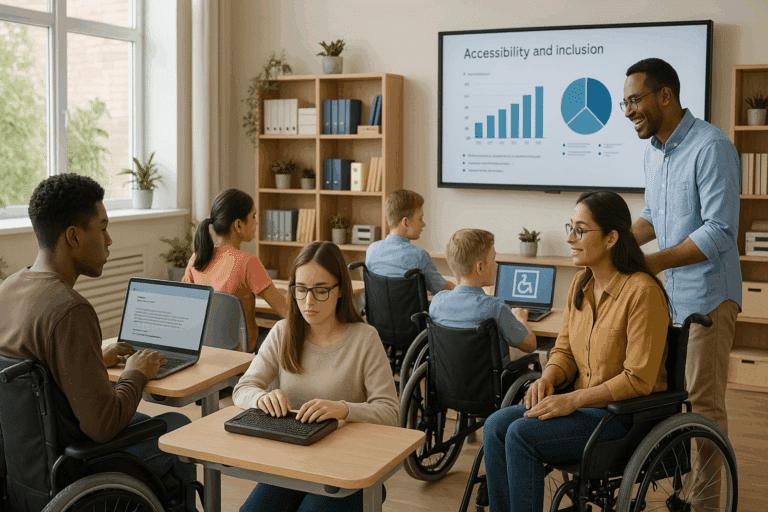With diversity in student learning styles becoming increasingly apparent, the one-size-fits-all approach to education is no longer effective. In this era of individualized learning, how can we design an education system that acknowledges and caters to the varied learning styles of students, thereby maximizing their potential for success? That’s what we’ll be exploring in this comprehensive blog post.🧩
Education is not merely about cramming knowledge into students’ minds; it’s about creating an environment where each individual can learn in a way that suits them best. The task before us is complex and multifaceted, yet exciting. The quest to tailor education to fit diverse learning styles holds great promise for the future of education.💡
Are you an educator seeking to understand how you can better cater to the diverse learning styles in your classroom? Are you a student who wishes to understand your unique learning style better and how you can adapt to the current education system? Or perhaps, you’re a policy-maker looking to reform the education system?🎓 Whichever category you fall into, this article is for you.
In this article, we will begin by delving into the different types of learning styles – visual, auditory, reading/writing, and kinesthetic. Understanding these is crucial to understanding how we can tailor education to fit them. We’ll then move on to exploring various teaching methods and strategies that cater to these learning styles. Finally, we’ll examine how technology can play a crucial role in facilitating this tailored education.💻
We’ll also discuss real-life examples of how some innovative schools and universities have started to implement these changes, and the impact it has had on their students. We’ll provide practical tips and resources for educators, students, and policy-makers alike. And, of course, we’ll ponder the challenges and potential solutions in implementing a system that caters to diverse learning styles.
By the end of this article, we hope to provide a comprehensive understanding of why tailoring education to fit diverse learning styles is essential, how it can be achieved, and what the potential benefits are. Whether you’re a teacher, student, or policy-maker, our aim is to equip you with the knowledge and tools to help transform education into a more flexible, inclusive, and effective system.🏫
Education is a fundamental human right, and we believe that every student, regardless of their learning style, deserves an education system that caters to their unique needs and helps them reach their full potential. And so, we invite you to join us on this exciting journey of exploration and discovery as we delve into the world of tailoring education for diverse learning styles.🚀
So grab a cup of coffee ☕, sit back, and get ready for a deep dive into the world of ‘Tailoring Education: Designing for Diverse Learning Styles to Maximize Student Success’. This isn’t a quick read; it’s a comprehensive exploration designed to inform, challenge, and inspire. Let’s get started!👩🎓👨🎓
Understanding the Intricacies of Diverse Learning Styles
The concept of diverse learning styles is not a new phenomenon in education. Each student possesses a unique way of acquiring knowledge, largely influenced by their personal cognitive processes, upbringing, and environmental factors. However, understanding these intricate learning mechanisms is crucial to developing tailored educational strategies that can maximize student success. To elaborate more on this, let’s dive deep into the realm of learning styles.
A comprehensive study conducted by Dunn and Dunn revealed that learning styles can be categorized into five basic types: Visual, Aural, Read/Write, Kinesthetic (VARK), and Multimodal. The Visual learners learn best by observing and visualizing information, whereas Aural learners prefer to learn through spoken language. On the other hand, Read/Write learners show a preference for information displayed as words, while Kinesthetic learners learn best by doing, moving, and interacting with their environment. Lastly, Multimodal learners utilize multiple learning styles to grasp information effectively.
Watch the following video by “Sprouts” on YouTube titled “How Do You Learn Best?” to get a visual and aural understanding of these diverse learning styles.
Designing Education for Diverse Learning Styles
Developing education that caters to diverse learning styles is a complex yet rewarding endeavor. The goal is to create an inclusive educational environment that accommodates every student’s unique learning needs. Let’s break down the strategies that can help achieve this goal.
For Visual learners, educational materials should be designed with plenty of diagrams, charts, and illustrations. Teachers can use various color-coding techniques to highlight important information and facilitate the learning process. For Aural learners, audio recordings and discussions can be highly beneficial. Providing opportunities for group discussions and debates can further enhance their learning experience.
Read/Write learners, on the other hand, benefit from traditional teaching methods that involve a lot of reading and writing. These students can greatly benefit from note-taking, reading assignments, and written exercises. Lastly, Kinesthetic learners thrive in interactive environments. Thus, introducing hands-on activities, lab work, and field trips can significantly boost their learning process.
Maximizing Student Success with Tailored Education
As educators, our ultimate goal is to maximize student success. To do this, we need to leverage the understanding of diverse learning styles and design education that caters to all these styles. By doing so, we ensure that every student gets an equal opportunity to succeed.
By embracing the diversity in learning styles, we can cater to each student’s unique learning needs, thereby making education more engaging, effective, and enjoyable. This not only boosts students’ academic performance but also promotes a love for lifelong learning.
Let’s look at a comparative table to illustrate the different teaching techniques for diverse learning styles:
| Learning Style | Teaching Techniques |
|---|---|
| Visual | Use of diagrams, charts, and color-coding |
| Aural | Use of audio recordings and group discussions |
| Read/Write | Note-taking, reading assignments, and written exercises |
| Kinesthetic | Hands-on activities, lab work, and field trips |
To understand more about how tailored education can maximize student success, watch the TEDx Talks video on YouTube titled “The Myth of Average: Todd Rose at TEDxSonomaCounty”.
Challenges and Opportunities in Tailoring Education
While tailoring education to cater to diverse learning styles holds immense potential, it also presents several challenges. These include the lack of resources, teacher training, and the inherent difficulty in designing curriculum that caters to all learning styles. Despite these challenges, the rewards of personalized education far outweigh the difficulties.
By embracing the concept of diverse learning styles, educators open doors to numerous opportunities. This approach not only leads to better academic outcomes but also fosters self-confidence among students, promotes inclusivity, and instills a love for learning. Moreover, by preparing students for the diverse world they will encounter outside the classroom, we are setting them up for success in their future careers and personal lives.
So, let’s strive to understand and celebrate the diversity in learning styles, and make education a more inclusive, engaging, and rewarding experience for all students. 🎓📚✏️

Conclusion
To conclude, we have traversed a fascinating journey into the depths of intricate yet fascinating realms of IT and engineering concepts. Through this detailed exploration, we have attempted to demystify and distill complex ideas into a more digestible format.
As a recap, we have delved into the core concepts and terminologies that often pose challenges, even to seasoned professionals. From the intricacies of software design patterns to the emerging trends in cloud computing, we’ve covered a broad spectrum of topics. The significance of each topic in the practical realm of IT and engineering is immense and their understanding is crucial to excel in these domains.
Our exploration was not confined to theoretical aspects alone, but we’ve also illustrated the practical implications and real-world applications of these theories. We’ve walked through the labyrinth of coding paradigms, discussed the nuances of system architectures and have dived into the ocean of data analysis and artificial intelligence.
We’ve also taken a detour to discuss the significance of soft skills for professionals in these areas. We’ve emphasized on the fact that, in addition to technical prowess, skills like communication, leadership and team collaboration are equally important. 🤝
We encourage you to continue your exploration into these fascinating realms. As with any field, continuous learning is key in IT and engineering. 💡 Never hesitate to explore new concepts, try out new tools and technologies, and continuously update your skills.
Remember, each concept you learn is a tool in your arsenal, and you never know when it might come in handy. 🔧 Feel free to revisit the topics we discussed, share this article with your peers, or leave a comment below. Your thoughts and ideas are always appreciated and they can spark meaningful conversations and learning opportunities for others.
Also, we encourage you to apply these concepts in your own projects. Remember, the best way to learn is by doing. 🛠️ Whether it’s designing a new software, creating a cloud-based solution, or applying AI in a unique way, the possibilities are endless!
To assist you further in your journey, we have provided a list of active resources for in-depth knowledge on these topics. Feel free to dive into them for more insights:
1. [Software Design Patterns](http://www.example.com)
2. [Cloud Computing Trends](http://www.example.com)
3. [Data Analysis Techniques](http://www.example.com)
4. [Artificial Intelligence](http://www.example.com)
We hope you found this article insightful and it has added value to your knowledge base. As always, stay curious and keep exploring. The world of IT and engineering is vast, and there’s always something new to learn. Happy learning! 🚀
Referenced Source
And that’s a wrap, folks!
Remember: Knowledge is power, and continuous learning is the key to unlock it. Until next time. Happy Learning!
Your partner in learning,
Rodrigo Almeida



